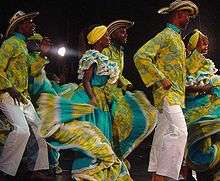Afro-Colombians
| Total population | |
|---|---|
|
4,944,400 (2017) (10.6% of Colombian population)[1] | |
| Regions with significant populations | |
| Predominantly in the Pacific Region of Colombia, some areas of the Caribbean natural region and urban areas across the country. | |
| Languages | |
| Colombian Spanish - San Andres Creole - Caribbean English - Yoruba - other African languages | |
| Religion | |
| Predominantly Roman Catholic, minorities of Protestant. |
Afro-Colombians refers to Colombian citizens of African descent; this article is about the influence they have had on Colombian culture. Colombia is considered to have the fourth largest Black African population in the western hemisphere, following Brazil, Haiti and the United States.
History

Africans first began coming as explorers in the first decade of the 16th century. By the 1520s, Africans were being imported into Colombia as slaves steadily, from places such as[2] Congo, Angola, Gambia, Nigeria, Cameroon, Liberia, Ghana, Ivory Coast, Guinea, Sierra Leone, Senegal and Mali (West Africa, in other words),[3] to replace the rapidly declining Native American population. African slaves were forced to work in gold mines, on sugar cane plantations, cattle ranches, and large haciendas. African labor was essential in all the regions of Colombia, even until modern times. African workers pioneered the extracting of alluvial gold deposits and the growing of sugar cane in the areas that correspond to the modern day departments of Chocó, Antioquia, Cauca, Valle del Cauca, and Nariño in western Colombia.
In eastern Colombia, near the cities of Vélez, Cúcuta, Socorro, and Tunja, Africans manufactured textiles in commercial mills. Emerald mines, outside Bogotá, were wholly dependent upon African laborers. Also, other sectors of the Colombian economy like tobacco, cotton, artisanry and domestic work would have been impossible without African labor. In pre-abolition Colombian society, many Afro-Colombian captives fought the Spanish and their colonial forces for their freedom as soon as they arrived in Colombia. It is clear that there were strong free Black African towns called palenques, where Africans could live as cimarrones, that is, they who escaped from their oppressors. Afro Panamanians are also related to Afro-Colombians, some historians consider that Chocó was a very big palenque, with a large population of cimarrones, especially in the areas of the Baudó River. Very popular cimarrón leaders like Benkos Biojó and Barule fought for freedom. African people played key roles in the independence struggle against Spain. Historians note that three of every five soldiers in Simon Bolívar's army were African. Not only that, Afro-Colombians also participated at all levels of military and political life.

In 1851 the life of the African Colombians was very difficult. African Colombians were forced to live in jungle areas as a mechanism of self-protection. There, they learned to have a harmonious relationship with the jungle environment and to share the territory with Colombia's indigenous.
From 1851, the Colombian State promoted the ideology of mestizaje, or miscegenation. So in order to maintain their cultural traditions, many Africans and indigenous peoples went deep into the isolated jungles. Afro-Colombians and indigenous people were, and continue to be, the targets of the armed actors who want to displace them in order to take their lands for sugar cane plantations, for coffee and banana plantations, for mining and wood exploitation.
In 1945 the department of El Chocó was created; it was the first predominantly African political-administrative division. El Chocó gave African people the possibility of building an African territorial identity and some autonomous decision-making power.[4]
Demographics
.svg.png)

In the 1970s, there was a major influx of Afro-Colombians into the urban areas in search of greater economic and social opportunities for their children. This led to an increase in the number of urban poor in the marginal areas of big cities like Cali, Medellín and Bogotá. Most Afro-Colombians are currently living in urban areas. Only around 25%, or 1.2 million people, are based in rural areas, compared to 75%, or 3.7 million people in urban zones. The 1991 Colombian Constitution gave them the right to collective ownership of traditional Pacific coastal lands and special cultural development protections. Critics argue that this important legal instrument has not been enough to completely address their social and developmental needs.[4]
Afro-Colombians make up 10.6% of the population, almost 5 million people, according to a projection of the National Administrative Department of Statistics (DANE),[6] most of whom are concentrated on the northwest Caribbean coast and the Pacific coast in such departments as Chocó, whose capital, Quibdó, is 95.3% Afro-Colombian as opposed to just 2.3% mestizo or white.[7] Considerable numbers are also in Cali, Cartagena, and Barranquilla. Colombia is considered to have the fourth largest Black/African-descent population in the western hemisphere, following Haiti, Brazil and the USA.
It has been estimated that only 4.4 million Afro-Colombians actively recognize their own black ancestry, while many other African Colombians do not, as a result of inter-racial relations with white and indigenous Colombians.[8] Afro-Colombians may often encounter a noticeable degree of racial discrimination and prejudice, possibly as a socio-cultural left over from colonial times. They have been historically absent from high level government positions. Many of their long-established settlements around the Pacific coast have remained underdeveloped.[8] In Colombia's ongoing internal conflict, Afro-Colombians are both victims of violence or displacement and members of armed factions, such as the FARC and the AUC. African Colombians have played a role in contributing to the development of certain aspects of Colombian culture. For example, several of Colombia's musical genres, such as Cumbia and Vallenato, have African origins or influences. Some African Colombians have also been successful in sports.
Raizals
The Raizal ethnic group is an Afro-Caribbean group living in Archipelago of San Andrés, Providencia and Santa Catalina, speaking the San Andrés-Providencia Creole.
Notable Afro-Colombians
- Juan José Nieto Gil, first and only Afro-Colombian President of the Republic
- Caterine Ibargüen, athlete
- Faustino Asprilla, footballer
- Éder Álvarez Balanta, footballer
- Jacob Bush (DJ BUXXI), producer/composer/singer from San Andres.
- Vanessa Alexandra Mendoza Bustos, Miss Colombia 2001 winner and fashion model
- Piedad Córdoba, politician
- Antonio Cervantes, boxer from San Basilio de Palenque
- Juan Cuadrado, footballer
- Raul Cuero, scientist
- Jackson Martínez, footballer
- Yerry Mina, footballer
- Luis Gilberto Murillo, politician
- Manuel Zapata Olivella, writer
- Édgar Rentería, Major League Baseball player
- Freddy Rincón, footballer
- Elkin Robinson, musician/composer/producer from Providence
- Davinson Sánchez, footballer
- Maria Isabel Urrutia, first Olympic gold medal winner for the country
- Carlos Valderrama, footballer
- Jealisse Andrea Tovar Velásquez, Miss Colombia 2015 winner and fashion model
- Paula Marcela Moreno Zapata, politician
See also
References
- ↑ Woods, Sarah; McColl, Richard (2015-09-01). Colombia. Bradt Travel Guides. ISBN 9781841629216.
- ↑ "African Origins of AfroColombian Lastnames" (PDF). Clopedia Afrocolombiana.
- ↑ "African Origins of AfroColombians". AfroColombia NY. Archived from the original on 8 April 2016. Retrieved 22 May 2016.
- 1 2 Gilberto Murillo, Luis (23 February 2001). "El Chocó: The African Heart of Colombia". Columbian Human Rights Network. Retrieved 9 October 2016.
- ↑ Fundación Hemera (2007). "Ethnic groups: Afro-Colombians". Ethnicities of Colombia (in Spanish). Archived from the original on 22 February 2008. Retrieved 29 December 2007.
- ↑ "La visibilización estadística de los grupos étnicos colombianos" [The statistical visibility of Colombian ethnic groups] (PDF). Colombian National Administrative Department of Statistics (in Spanish). 2006. Retrieved 9 October 2016.
- ↑ "Perfil: Censo General 2005" [Profile: General Census 2005] (PDF). Colombian National Administrative Department of Statistics (in Spanish). 14 September 2010. Retrieved 9 October 2016.
- 1 2 Salazar, Hernando (25 May 2007). "¿Colombia hacia la integración racial?" [Is Colombia moving toward racial integration?] (in Spanish). BBC.com.uk. Retrieved 9 October 2016.
External links
| Wikimedia Commons has media related to African Colombians. |
- Afro-Colombian Solidarity Network <http://www.afrocolombian.org>
- AfroColombiany.org AfroColombian News in English.
- CNN video of Afro-Colombian community
- Colombian 2005 Census Television Commercial Orgullosamente Afrocolombiano
- The World Bank's Sector Report "The Gap Matters: poverty and well-being of Afro-Colombians and indigenous peoples" Click here for the report
- African-Diasporic Regions of Colombia plus more COLOMBIAFRICA
- Documentary 150 years after abolition Libertad En Colombia (Liberty In Colombia)
- Colombia contra el racismo
- "Law 70: English Translation of Ley 70"